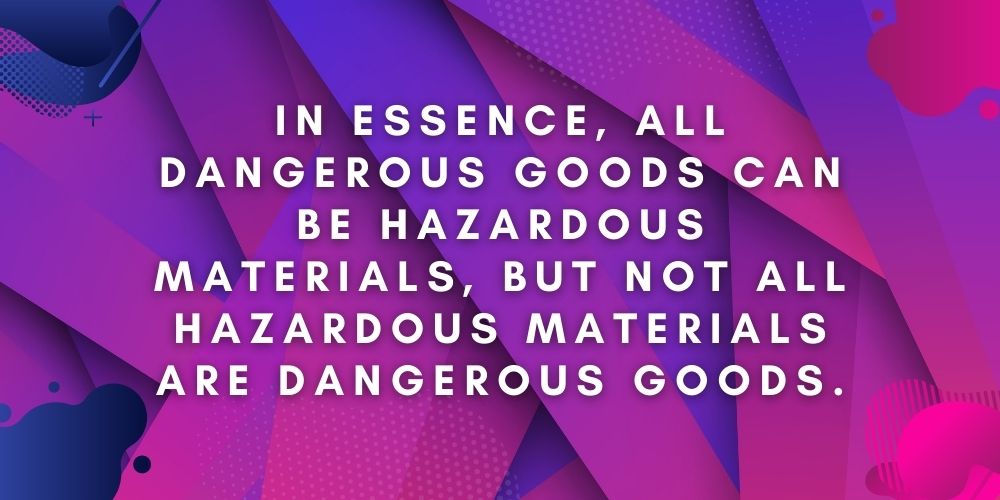Dangerous Goods Function Specific Training And Assessment For Shippers By Air Course 2025
Enroll in Dangerous Goods Training – Navigating the intricate world of dangerous goods and hazardous materials transportation is like walking through a minefield. One wrong step could result in regulatory non-compliance, hefty fines, and severe safety risks.
The silver lining?
This comprehensive guide to dangerous goods training is designed to help you sail smoothly through these choppy waters.
Whether you’re an air shipper seeking to optimize operations or a safety officer aiming for stricter regulatory compliance, this is your one-stop resource.
Save Thousands Of Dollars With Coggno Prime Subscription
What are Dangerous Goods?
What are dangerous goods? According to the International Air Transport Association (IATA), dangerous goods are items or substances that pose risks to health, safety, property, or the environment.
Examples of dangerous goods are prevalent and varied, from flammable liquids like gasoline to corrosives such as battery acid or radioactive materials utilized in medical treatments.
Comprehensive Safety Awareness Training Course Bundle (Includes 97 Courses)
What are Hazardous Materials?
Similarly, hazardous materials – or HazMat – are substances potentially harming living organisms, the environment, or property. Per the IATA’s description, this classification can include biohazardous substances like certain bacteria and viruses, toxic chemicals, or explosives.
In essence, all dangerous goods can be hazardous materials, but not all hazardous materials are dangerous goods.
List of Dangerous Goods
Dangerous Goods – While a comprehensive list of dangerous goods is extensive, the International Air Transport Association (IATA) categorizes them into nine classes for simplicity:
1. Explosives
These are substances or articles capable of producing a dangerous explosion, such as dynamite or fireworks.
Fire Prevention And Safety Course
2. Gases
This class includes substances in the gaseous state at room temperature and pressure. They can be further subdivided into flammable, non-flammable, and toxic gases.
3. Flammable Liquids
These liquids can readily catch fire under most conditions. Examples include gasoline and alcohol.
4. Flammable Solids
Substances that, under transport conditions, are readily combustible or may cause or contribute to fire through friction. Examples include matches and metal powders.
5. Oxidizing Substances and Organic Peroxides
These substances may cause or contribute to combustion by yielding oxygen. Examples include hydrogen peroxide and nitric acid.
6. Toxic and Infectious Substances
These substances can cause death or injury if swallowed, inhaled, or by skin contact. Infectious substances are those which are known to contain or are reasonably expected to contain, pathogens.
7. Radioactive Material
Any material containing radionuclides where the activity concentration and the total activity in the consignment exceed certain predefined values.
8. Corrosives
Substances that can cause severe damage to skin, eyes, or cargo materials, such as acids or alkaline solutions.
9. Miscellaneous Dangerous Goods
These are substances that present danger and are not covered elsewhere. This includes environmentally hazardous substances, genetically modified organisms, and lithium batteries.
Must Read – Best Online Welding Courses
How Does Dangerous Goods Function Specific Training Optimize Commercial Operations for Air Shippers?
Function-specific training for shippers, tailored to the unique needs of air shippers dealing with dangerous goods, is more than a regulatory requirement. It’s a strategic tool that paves the way for efficient, compliant, and safe operations.
For example, proper training can help your organization avoid costly delays caused by incorrect documentation or packaging errors. Moreover, a team versed in the IATA 63rd Edition of regulations can confidently handle any dangerous goods-related scenario, reducing the risk of non-compliance and potential fines.
Why are Dangerous Goods Training Important?
Following are the reasons why dangerous goods training is important:
Safety Compliance Solutions
Effective training ensures safety protocols are correctly implemented and maintained, reducing the risk of accidents and promoting a safer workplace.
Risk Management Services
It empowers your team to identify, assess, and mitigate potential hazards related to dangerous goods, hazardous material handling, and transportation.
Process Safety Management: Operating Procedures (US) Course
Regulatory Compliance
It ensures adherence to strict IATA, DOT, and other regulations, thus preventing legal issues and financial penalties.
Emergency Response Planning
In the event of a dangerous goods incident, well-trained staff can respond swiftly and effectively, mitigating potential harm.
Emergency Response Plan Course
Enhancing Reputation
Companies prioritizing dangerous goods training display a commitment to safety and compliance, boosting their image among clients and partners.
Best Course for Dangerous Goods Training
The Dangerous Goods Function Specific Training and Assessment for Shippers by Air (ICAO/IATA Edition 63) course is designed explicitly for hazmat employees involved in preparing shipments for air transport under the International Air Transport Association (IATA) Dangerous Goods Regulations (DGR).
Authored by Currie Associates, a leading name in the industry, this course satisfies the regulatory training standards prescribed by 49 CFR §172.704 and the IATA Dangerous Goods Regulations Subsection 1.5.
The Target Audience: Who Should Enroll?
This detailed training course caters to shippers, third-party storage and logistics solutions companies, and freight forwarders who handle, package, mark, label, prepare, or validate shipping papers.
It is also beneficial for dangerous goods employees and their supervisors.
Learning Objectives: What’s In Store?
The primary goal of the course is to help attendees confidently navigate the IATA DGR.
It helps you understand the intricacies of
- Classification or identification;
- Selecting and filling packaging;
- Marking, labeling, applying limited quantity;
- Expected quantity exceptions; and
- Documentation requirements for the safe transportation of dangerous goods by air.
Course Curriculum: Detailed Breakdown
The course covers an extensive range of topics, including:
- An Introduction to dangerous goods;
- Understanding the Limitations;
- Classification of dangerous goods;
- The List of Dangerous Goods;
- Packaging guidelines;
- Excepted Quantities and Limited Quantities;
- Marking and Labeling norms;
- Documentation requirements
Essential Resources and References
The course curriculum recommends referring to the IATA DGR – International Air Transport Association Dangerous Goods Regulations (63rd edition) book, which can be purchased.
The IATA 2022 Lithium Battery Guidance Document is also a key reference for free download. Other recommended resources include the DOT Chart 17 and the Emergency Response Guidebook 2020, both freely downloadable.
Prerequisites and Course Features
Prospective attendees are required to have completed the Hazardous Materials/Dangerous Goods Transportation General Awareness & Security Awareness Training before enrolling in this course. The course, conducted in English, runs for four hours. It includes a final assessment to validate the learner’s understanding of the material.
On successful completion, a training certificate will be issued. However, it is important to note that the training certificates issued by Currie Associates do not meet the requirements for a CNS endorsement application and will not reflect IATA accreditation.
Dangerous Goods Function Specific Training Course
Learning Outcomes: Enhancing Competencies and Building Proficiencies
The Dangerous Goods Function Specific Training and Assessment for Shippers by Air (ICAO/IATA Edition 63) course is designed to give attendees specialized skills and a comprehensive understanding of key aspects of air transport of dangerous goods.
After completing this course, attendees will be adept in the following areas:
- Understanding and Navigating the IATA DGR: The course empowers attendees to confidently navigate the IATA Dangerous Goods Regulations Shippers and Packers, a critical resource for all individuals involved in the air transportation of dangerous goods.
- Determining Classification/Identification: Attendees will be proficient in identifying and classifying different dangerous goods per the stipulations IATA laid out.
- Selecting and Filling Packaging: The course arms attendees with the knowledge to correctly select appropriate packaging and execute packaging procedures for various types of dangerous goods.
- Marking and Labeling: The course provides insights on properly marking and labeling dangerous goods packaging, ensuring compliance with IATA guidelines.
- Applying Limited Quantity and Excepted Quantity Exceptions: Participants will become proficient in applying exceptions for dangerous goods transported in limited or excepted quantities.
- Mastering Documentation Requirements: The course provides a deep understanding of the documentation requirements for safely transporting dangerous goods by air.
Through these learning outcomes, attendees will meet and exceed the professional standards expected in the dangerous goods transportation sector, ensuring their operations adhere to the best practices in safety and regulatory compliance.
With this DGR training, you will have the knowledge required to comply with IATA DGR, ensuring safer and more efficient operations.
International Maritime Dangerous Goods Transportation Compliance
Coggno: An Online Training Powerhouse
In today’s rapidly evolving professional landscape, the need for high-quality, easily accessible, and industry-relevant training solutions has never been more crucial. It is where Coggno steps in, carving a niche for itself as a trusted online training platform.
Coggno is more than just an online learning provider founded to empower businesses and professionals. It’s a comprehensive learning ecosystem that caters to a wide spectrum of training needs across various domains, including dangerous goods training, compliance, software, and much more.
Coggno leverages advanced learning technologies and methodologies to deliver engaging, interactive, and impactful content. With a robust catalog of courses authored by seasoned industry experts, the platform ensures that the training is current but also practical and industry-specific.
One of the standout features of Coggno is its Learning Management System (LMS). This intuitive, user-friendly tool simplifies the learning journey by providing easy access to course materials, tracking progress, and enabling you to learn at your own pace.
The LMS also allows organizations to effectively manage and deploy training for their teams, making Coggno a perfect partner for corporate training initiatives.
Notably, Coggno is a pioneer in providing function-specific dangerous goods Consulting and training services.
For instance, the Dangerous Goods Function Specific Training and Assessment for Shippers by Air (ICAO/IATA Edition 63) course exemplifies Coggno’s commitment to quality and relevancy. By offering courses that cover the latest industry regulations, Coggno helps you to stay ahead of the curve, enhancing your skills and boosting your career prospects.
Accessibility and flexibility are at the heart of Coggno’s learning approach. Regardless of your location or schedule, you can access Coggno’s comprehensive suite of courses at your convenience. This flexibility enables continuous learning and professional development without disrupting your daily routine.
The platform also offers a unique pay-per-use model, making professional training and development affordable and accessible to a broader audience. With Coggno, you pay for what you need when you need it – eliminating the need for long-term commitments or hefty upfront costs.
Conclusion
Dangerous goods and hazardous materials are omnipresent in various industries, and their proper handling is paramount. The importance of comprehensive Dangerous Goods Training cannot be overstated – it ensures safety, regulatory compliance, and efficient operations.
From understanding the intricacies of IATA regulations to picking the right training course, like the Dangerous Goods Function Specific Training and Assessment for Shippers by Air (ICAO/IATA Edition 63), we’ve covered every facet to assist you in this journey.
So, take a step forward and prioritize safety and compliance today.




















